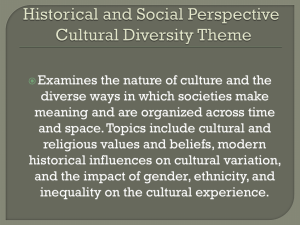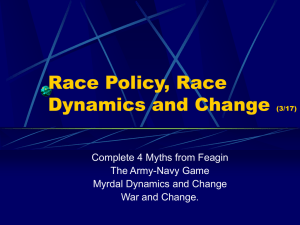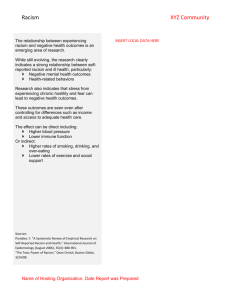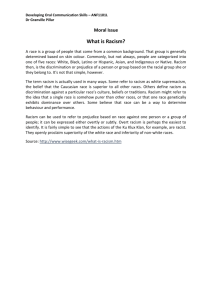Racial Inequality and Racism
advertisement
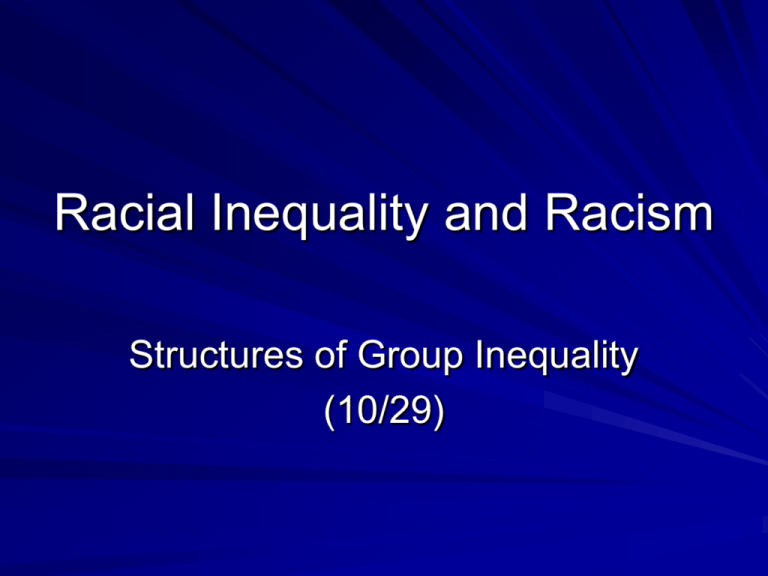
Racial Inequality and Racism Structures of Group Inequality (10/29) What does it mean to say that racism is “systemic?” 1. 2. 3. 4. 5. 6. It does not mean that most people in the society are prejudiced, though they may be. The inequality between slaves and slaveowners cumulates; it does not end with the death of the slaveowner or the abolition of slavery. The system changed its form but not its nature. It involves many interdependent characteristics. The Northern elite benefited indirectly. The relations to Native Americans, Hispanics, Asian Americans or white ethnics are part of a system whose distinctive US traits are racist. What is a “race,” sociologically A race is any group that is considered (by itself and by others) to be a race. Races are socially constructed. Visible differences are neither necessary nor sufficient for sociological races. Therefore relations between ethnic and religious groups may become or may stop being treated as racial. – E.g. Cherokee, South Phil., Israel, U.S. Army – Access to resources is a main part of those relations. The one drop rule in the US. Traditionally, U.S. black-white race relations have been governed by the unusual rule that one is “black” if any of one’s ancestors is “black.” This was necessitated by the unique set of social, legal and political structures of slavery and Jim Crow. i.e. gov’t mandated segregation when most “blacks” had white ancestors. What are the racial regimes? 1. 2. 3. 4. 5. Genocide: the attempted extermination of an entire people. Expulsion: the forced transfer of a population to another area or to camps. Subjugation: the creation of a second class citizenship. Segregation: systematic social separation. Assimilation: social melting pot. What have been the regimes in the US? All five regimes appear in American history. The text suggests that the elimination of most Native American tribes was unintended. I disagree. Chattel slavery was a unique institution, although all forms of slavery are extremely degrading and destructive of the family, etc. And Jim Crow was a nearly unparalleled institutional subjugation. How much is U.S. race is a matter of black v. white? Often the central issue is how similar black/white relations are to ethnicity. Feagin argues that they are dissimilar, but black/ white relations are central because: relations of Europeans to Native Americans, Chinese, and Hispanic Americans were shaped by slavery. Immigrant groups struggled to define themselves as “not black” by separating themselves from blacks. Sociology, Micro, Macro and Mega spends about 4 times as much space on other groups. Peculiarities of U.S. slavery Race relations in the US have a distinct dynamic largely because slavery was unique. Unlike Latin America, in the U.S. the definition of slaves as property was not checked by any structure of family or other kinds of rights. And it was often accompanied by rituals of dehumanization. E.g. slaves eating from a trough, female slaves as fair game, and slave testimony or rights as impossible. Laws against teaching slaves to read. But isn’t that ancient history? Many people say that that was then and this is now; blacks should get over it. For Feagin, if Fred has stolen money from Joe, Fred can ask Joe to “Get over it” only after he has given back the money. One index of how a society has progressed is who it honors. Who is the American that has the most monuments to his memory? Bedford Forrest – founder of the KKK. Why? The dynamic of race today Table 21.4 (*p.406) details “four centuries of legal progress and setbacks.” different people conceive of that dynamic in different ways. There has been a sharp decline of views such as “There should be laws against intermarriage,” (though 10% to 20% of the white pop. still agrees with such items.) But there has also been a decline in support for reducing existing inequalities. The relation of racial inequalities Myrdal’s argument was that group advantages reinforce each other, often as a self-fulfilling prophecy. + Resources Access to further resources + • Example: A businessman who cannot get credit, is likely to go out of business, and therefore, he is a bad risk. •Other examples: health, education, crime, social contacts, addictions, neighborhood quality, work responsibility, work commitment, What is the relation between prejudice and racial inequality Myrdal’s argument was that racism and racial inequality reinforce each other. + Racism Racial Inequality + • This is sometimes wrongly interpreted to mean that “racism” is the individual sentiment that produces discriminatory behavior. Myrdal vs. Feagin Feagin criticizes Myrdal as proposing a model that seems to suggest an attitudinal model: Prejudice Discrimination Racism Feagin, as the theorist of institutionalized discrimination, argues that the relations go: Race inequality Discrimination Prejudice For example, profiling has an equally strong effect whether or not it is based on fact. Implications of Cumulative Causation for Myrdal: 1. The system is pervasive It creates a cascade of pervasive differences that appears as second nature, but is socially produced 2. The system is modifiable Such systems are unstable and amplify interventions. 3. But only by broad spectrum interventions It has the inertia of an avalanche These qualitative dynamic conclusions follow even when one cannot estimate specific component paths. Institutional discrimination and systemic racism Feagin suggests that over American history, racism, as a pervasive institutional system has maintained itself as a structure of inequality and privilege. Racism is not a matter of prejudice. It is can be maintained by relatively little individually prejudiced action (except opposition to change efforts). How much racial inequality is there? Feagin Racism directly or indirectly costs the average black American about 10% of their life span; 40% of their income; and 90% of their wealth. Sociology, Micro, Macro and Mega: 1990 White Black Hispanic % 4 yrs col. 22% 11% 9% % in poverty 11% 32% 28% Median income $36,915 $21,423 $23,431 Individual, Institutional and Cultural racism Individual racism is individual prejudice and/or discrimination Institutional racism are institutionalized structures that disadvantage a group, and which are often maintained for reasons having little to do with prejudice. Cultural racism is a belief in the superiority of European culture. Can blacks be racist Obviously anyone can be individually racist or prejudiced. But if racism is defined as the use of or connection with a monopoly of society’s institutionalized power, then you can only do that if you have that monopoly. Pit bull liability is not a matter of intent The relation between prejudice and discrimination: LaPierre In a classic study (from 1934) LaPierre p.*398 found almost no correlation between the willingness of hotels and restaurants to discriminate in practice and their saying that they would do so. Situational constraints and pressures were more important than set individual motives. Merton on the relation between prejudice and discrimination: Merton’s typology *p.398 Situational pressures may produce all four cases: Prejudice Discrimination No Discrimination “Active Bigot” “Timid Bigot” No prejudice “Fair weather liberal” “All weather liberal”
